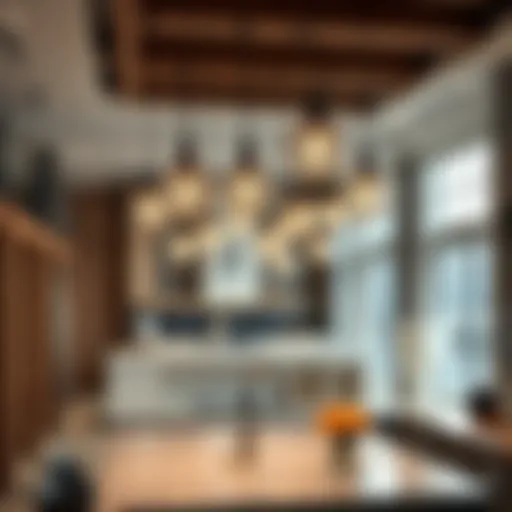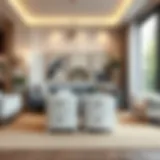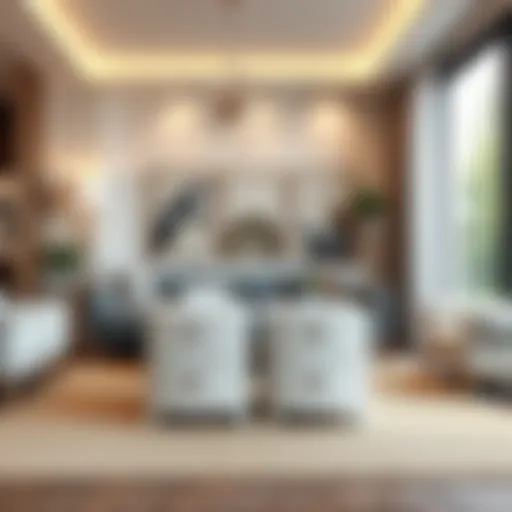Enhancing Living Room Design with Side Lights
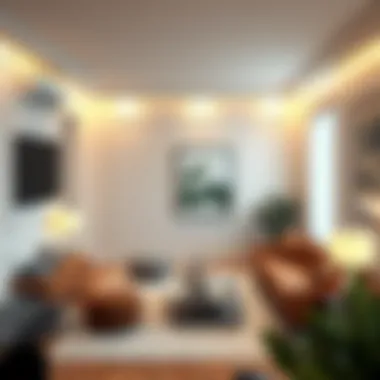
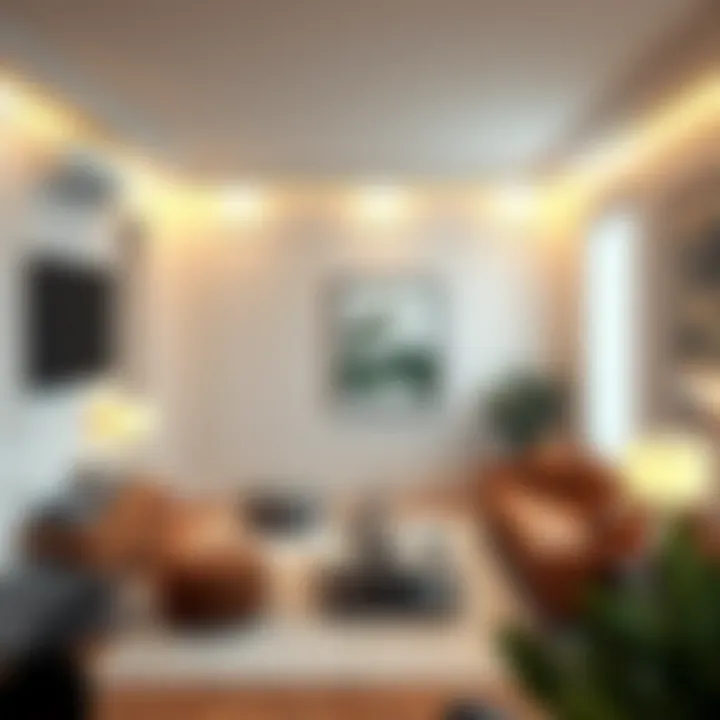
Intro
When it comes to designing a living room, the details can make all the difference. While furniture arrangements and color schemes often take center stage, one element that can elevate or diminish your space is the use of side lights. These fixtures not only enhance the aesthetic appeal but also play a pivotal role in establishing the right ambiance. They provide flexibility in lighting options, allowing homeowners to tailor the atmosphere of their living rooms to suit various needs from cozy movie nights to vibrant gatherings.
Understanding how to effectively incorporate side lights into your design can transform a mundane space into a sophisticated and inviting environment. From the types of fixtures to the placement techniques, there’s a world of possibilities when it comes to these illuminating accessories.
As we explore this topic, we will delve into contemporary design trends, practical tips for utilization, and insights into the materials and styles that resonate with today’s homeowners. This guide aims to arm you with the knowledge needed to enhance your living area through meticulous light choices, crafting a space that reflects both elegance and functionality.
Furniture Trends
Incorporating side lights into your décor isn’t simply about choosing an appealing fixture; it’s also about harmonizing these elements within the broader context of living room trends.
Current Design Trends
The trend for side lights has shifted significantly in recent years. In contemporary settings, the inclination is towards fixtures that offer a mix of form and function. Think sleek, minimalist designs that blend seamlessly with the overall room aesthetic. Moreover, designers are favoring lamps that feature adjustable brightness, allowing for customization based on time of day or activity.
Here are some popular trends:
- Geometric Shapes: Lamps with unconventional shapes can serve as statement pieces.
- Natural Materials: Wood and stone elements are trending, pairing beautifully with softer fabrics and textures.
- Vintage Styles: Nostalgic designs from the mid-20th century are making a comeback, adding character to modern rooms.
Popular Color Palettes
The right color scheme can significantly affect how side lights impact the overall vibe of your living space. Current popular palettes lean towards soft neutrals paired with bolder accent colors. Neutral bases allow side lights to stand out without overwhelming the décor.
- Muted Whites and Grays: Timeless and sophisticated, these colors work wonders in creating a fresh backdrop.
- Earth Tones: Shades like terracotta and moss green evoke warmth and a homely feel, enhancing the cozy factor.
- Bold Accents: Think deep blues or rich burgundies as accents to draw the eye towards beautifully designed side lights.
"The right side light can truly redefine your space by marrying style with purpose."
Practical Tips
Once you've grasped the current trends, the next logical step is to understand how to apply this knowledge effectively in your own living room.
Furniture Maintenance and Care
To maintain the allure of your side lights, regular cleaning and occasional updates to bulbs are crucial. Dusting the fixtures weekly keeps them looking fresh. For materials like fabric shades, a gentle vacuum or lint roller can eliminate dust build-up.
Space Utilization Strategies
Placement is everything. Side lights should accentuate your furnishings, not compete with them. Here are a few strategies to consider:
- Position lights beside seating areas to create soft pools of light.
- Use adjustable fixtures on side tables for versatility.
- Aim for balance by mirroring side light placement across the room for a symmetrical look.
By understanding these elements, you're not just adding lights to your living room but creating a thoughtfully designed space that maximizes function and beauty.
Understanding Side Lights
Side lights play a crucial role in living room design, contributing to both the aesthetic appeal and functionality of a space. When thoughtfully incorporated, these lights can create a warm atmosphere, enhancing the overall experience of anyone entering the room. They serve not only as sources of illumination but also as design elements that complement the overall decor scheme. Understanding the intricacies of side lighting becomes essential for homeowners, designers, and DIY enthusiasts alike as they navigate the vast options available.
One of the primary benefits of incorporating side lights is their ability to define spaces. By casting light in specific areas, they can draw attention to architectural details or art pieces on the walls. This targeted illumination can transform a plain living room into a gallery of sorts, where every corner tells a story and showcases its character. Furthermore, the ambiance of a room can shift dramatically based on the style and intensity of the side lights chosen.
In addition to their aesthetic advantages, side lights also offer practical benefits. They provide functional illumination for activities such as reading, entertaining guests, or simply enjoying a quiet evening at home. Selecting the right side lighting can mean the difference between navigating in dim light and effortlessly enjoying every moment in a cozy corner of your living room.
Another consideration is the placement and design of side lights. The right fixtures can enhance or disrupt the flow of your living room's overall design. Therefore, understanding the various elements at play allows individuals to make informed decisions about what contributes to the functionality and beauty of the space. In summary, mastering the art of side lighting paves the way for a well-lit, inviting living room that resonates with comfort and visual interest.
Defining Side Lights
Side lights, often referred to as accent lights, offer targeted illumination that exists outside the primary overhead lighting. These fixtures, which come in various forms like table lamps, sconces, or even floor lamps, are strategically placed to enhance the ambiance of a room without overwhelming it. By illuminating specific areas, side lights can create layers of light, inviting a more complex and engaging atmosphere.
The term 'side lights' can encompass a range of lighting options, but their fundamental characteristic remains the same: they are designed to complement the existing lighting scheme of a room while serving a distinct purpose. Not only do they provide illumination, but they also help delineate spaces, enhance decor features, and contribute to the overall mood of a living area.
Historical Context
Historically, lighting in homes has evolved significantly. From flickering candles to gas lamps, and now to modern electric lighting, the approach to illumination reflects broader shifts in design philosophy and technological advancement. In earlier decades, side lights were often dependent on their capability to provide sufficient light for household tasks. However, it wasn't long before aesthetics began to merge with functionality.
In the Victorian era, the introduction of gas lamps led to the idea of decorative lighting as an art form. Sconces adorned with intricate designs were commonplace, while table lamps adorned dining tables and drawing rooms. Fast forward to the mid-twentieth century, and we see a new wave of modern design that placed an emphasis on minimalism and form.
Today, understanding the historical context of lighting brings forth a greater appreciation of its current role in design. Side lights are now crafted not just for illumination but also as artistic statements within the living room. Recognizing this history can enrich our approach, allowing us to choose fixtures that resonate with personal taste while also respecting design traditions.
Design Styles Influencing Side Lights
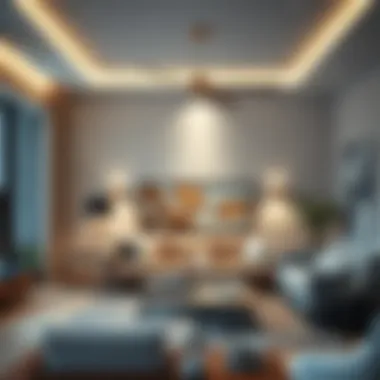
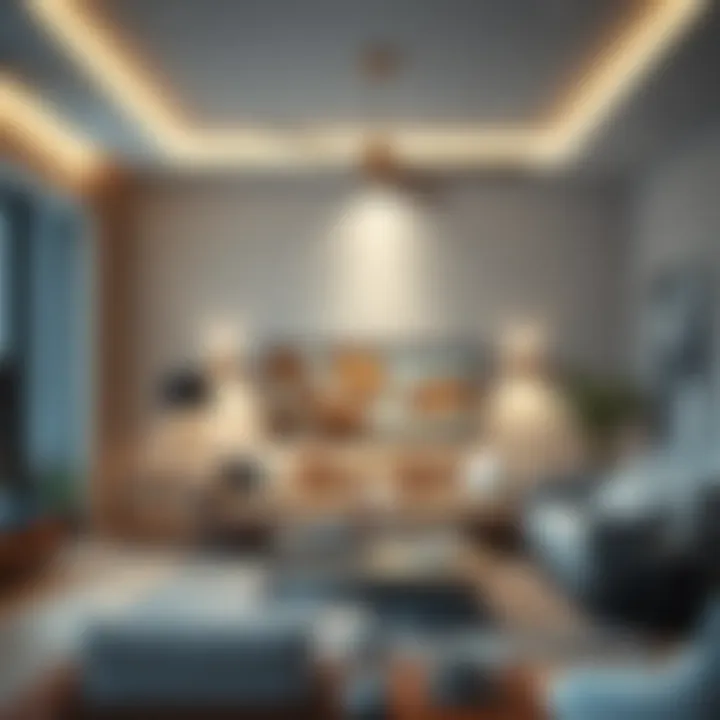
The design of a living room is more than just choosing paint colors and furniture arrangements. A pivotal aspect of this decor journey lies in the selection of side lights, which can draw together various elements to create a cohesive and inviting atmosphere. The influence of different design styles plays a significant role in how side lights are perceived and utilized within these spaces. Whether a home leans towards modern minimalism or embraces the warmth of classic elegance, side lights can accentuate the overarching aesthetic by offering tailored illumination solutions.
Each design style brings its own flavor and unique benefits, which affect how side lighting interacts with the overall ambiance. Understanding these styles not only helps in selecting appropriate fixtures but also aids in crafting a functional layout that enhances the living environment. Below, we explore how particular styles impact the choices of side lights, allowing homeowners and designers alike to create spaces that resonate personally and aesthetically.
Modern Minimalism
Modern minimalism focuses on simplicity and clean lines. In a minimalist living room, side lights serve a purpose beyond mere illumination; they are accent pieces that enhance the sleekness of the environment. Fixtures often favor neutral tones and geometric shapes, aligning with the uncluttered philosophy of the style.
Examples of suitable side lights for this style include:
- Simple LED floor lamps with a metallic finish
- Wall sconces that hug the wall with a flush-mount design
Such lights can create an illusion of space while providing concentrated light for specific tasks, such as reading. In these designs, less is more, and the understated elegance of the side lights complements the overall minimalistic feel of the room.
Industrial Aesthetic
The industrial aesthetic marries raw materials with a sophisticated edge. Characterized by exposed brick, metal elements, and wooden accents, this style thrives on textures and contrasts. Side lights in an industrial setting often have a rugged quality, frequently made from materials like wrought iron or distressed finishes.
Common attributes in industrial side lights include:
- Edison bulb fixtures that highlight the vintage feel
- Pipe-style floor lamps that evoke a factory vibe
Choosing side lights that reflect the raw essence of the materials used throughout the living room brings together the whole design concept. The right lighting can amplify the boldness of this aesthetic while retaining a warm, inviting atmosphere.
Classic Elegance
Classic elegance is all about timeless sophistication. Rich fabrics, ornate furnishings, and a blend of warm tones characterize this style. Side lights selected for such spaces should harmonize with the grandeur and traditional elements often found in classic designs.
Suitable lighting options include:
- Crystal chandeliers paired with understated table lamps
- Decorative wall sconces that add visual interest
An important consideration in this style is the balance of light; side lights can fill in shadows created by larger fixtures and produce a soft glow that enhances the inviting nature of the room. They should convey luxury while functioning effectively, embodying elegance without overwhelming simplicity.
Eclectic Touches
Embracing a mix-and-match philosophy, eclectic design allows for personal expression and creativity. Here, side lights often stand out as unique pieces, reflecting individual tastes and various influences. The beauty of this style lies in the ability to combine contrasting elements into a harmonious whole, with side lights playing a crucial role.
In an eclectic living room, side lights might range from:
- Vintage mini lamps found at thrift stores
- Bold, statement-making floor lamps
These choices can add flair to the decor, ensuring the lighting remains functional while serving as conversation starters. The key is to blend different materials, shapes, and styles, creating a dynamic interplay that remains coherent and visually appealing.
"In lighting, as in art, the combination of styles creates depth and intrigue, inviting exploration and dialogue."
When selecting side lights based on these diverse design styles, it becomes clear that their purpose extends beyond utility—they are vital elements that shape living room aesthetics and functionality.
Importance of Side Lighting
Side lighting plays a pivotal role in the design of any living room. It adds depth and personality to the space while providing practical benefits. By incorporating side lights, homeowners can transform the atmosphere, showcasing their unique style and enhancing the overall experience within the room. The importance of side lighting can't be overstated; it balances the room's functionality with aesthetic charm, ultimately guiding design choices and user experiences.
Enhancing Ambiance
Creating a pleasant atmosphere is central to any room design, particularly in a living room where one spends leisure time. Side lights have the power to set the mood, varying from soft and mellow to bright and energizing. The layered lighting approach allows for different uses at various times—bright light for reading or softer illumination for gatherings.
One simple yet effective way to utilize side lighting is by using table lamps or floor lamps in strategic places. For instance, if one places a lamp next to a comfortable chair, it becomes an inviting nook for relaxing with a book. Lighting should never be an afterthought; it needs to be integrated into the design from the start.
- Think about the color temperature of the bulbs. Warmer tones can create a cozy vibe, while cooler tones are invigorating.
- Use dimmers where possible. Adjusting brightness can instantly change the room's feel, making it intimate or open as required.
"Ambiance can transform an ordinary evening into an extraordinary experience."
Functional Illumination
In terms of functionality, side lights are indispensable for practical uses. They serve as task lighting, illuminating areas where detailed work might take place, like reading, writing, or puzzles. They can also highlight the different zones within a living room, guiding attention without overwhelming the senses.
The choice of fixture directly affects the room's utility. For example, a swing-arm wall sconce provides adjustable light, fulfilling specific needs while saving space on surfaces. In contrast, a well-placed table lamp can act as both decoration and a source of light, combining functionality with style seamlessly.
Considering the balance of overhead lighting with side lights ensures that shadows and bright spots don’t compete uncomfortably. Cohesion in lighting strategies not only improves visibility but fosters a warm environment.
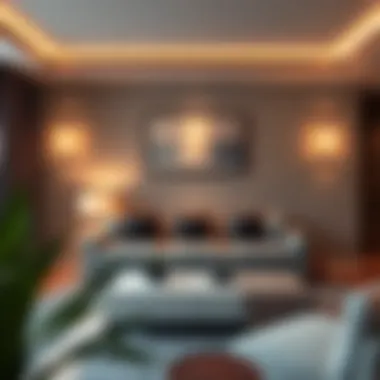
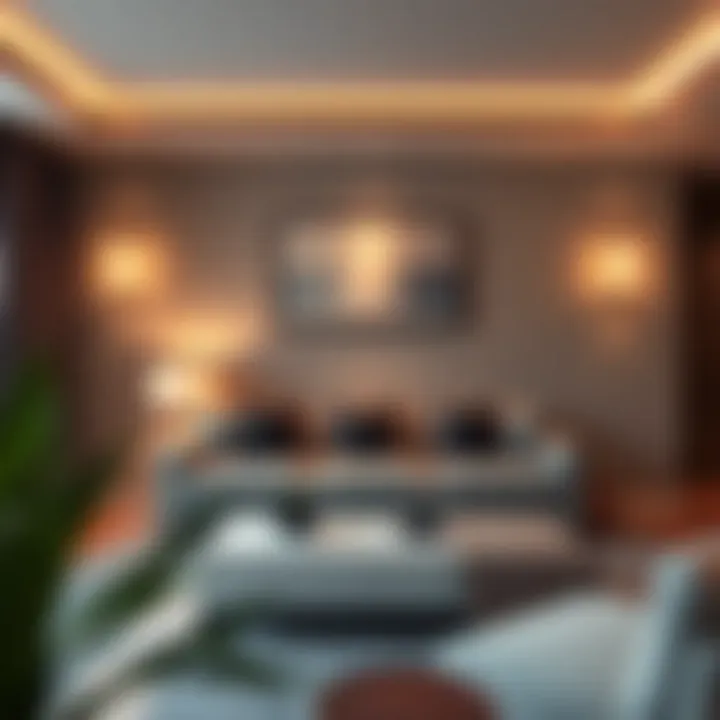
In essence, understanding the importance of side lighting helps in achieving a refined balance between ambiance and practicality. Whether aiming for intimacy or vibrancy, side lighting adapts and enhances the living area, serving as a fundamental aspect of effective design.
Selecting the Right Side Lights
Selecting the right side lights is a pivotal aspect of interior design that significantly influences the overall feel of a living room. This decision can determine how comfortable and inviting the space feels while also making a subtle statement about your personal style. From the preferred materials to the size of the fixtures, every choice interacts with the ambience and functionality of the room. When homeowners or designers embark on this journey, it's crucial to consider both aesthetic and practical aspects.
Material Choices
Metal
Metal fixtures, such as those made from brass or iron, are often lauded for their durability and sleekness. One of the standout characteristics of metal is its ability to blend seamlessly into various styles, from modern to industrial. The shiny finish of metal can create a bold contrast against softer textures or colors in the living room, drawing the eye without overwhelming the senses.
This quality makes metal a popular choice for those who seek longevity and a touch of elegance. However, one must keep an eye on maintenance; certain metals may tarnish or show fingerprints more than others, requiring regular cleaning to maintain their luster. Therefore, the unique feature of metal lighting lies in its combination of strength and style, but the potential need for upkeep can’t be ignored.
Glass
Glass side lights bring a certain clarity to a room, often contributing to a feeling of spaciousness. The key characteristic of glass is its transparency, which allows light to flow freely and creates an illusion of openness. Moreover, glass can be shaped into various designs, from sleek and modern to intricately detailed. This versatility makes it a beneficial addition in any contemporary living space.
However, while glass fixtures can add elegance, they also require careful placement to avoid being overshadowed by competing decor. A unique feature of glass is its ability to refract light, casting intriguing patterns that dance across walls. Nonetheless, those with lively households may need to be cautious; glass can be more delicate than other materials, leading to potential breakage.
Wood
Wooden side lights often bring warmth and character into a living room. The natural grains and textures found in wood add a rich depth that can soften the look of a space. This characteristic makes wood a favored option among those aiming for a cozy or rustic aesthetic. Wooden fixtures can create a sense of comfort, inviting guests to relax and unwind.
What makes wood particularly appealing is its eco-friendly nature, especially when sourced sustainably. However, wood is susceptible to moisture and can warp or fade over time if not properly treated. Thus, while it offers a unique feature of organic beauty, the advantages must be weighed against the considerations of maintenance and placement in a living environment.
Size Considerations
When it comes to size, balance is the name of the game. Choosing side lights that are too small can leave the space feeling incomplete, while those that are overly large can dominate the area and feel like a style faux pas. Determining the right size involves assessing both the scale of your furniture and the overall layout of the room.
One approach is to think about the light's proportional height; ideally, the bottom of the fixture should align with eye level when seated. This ensures that the light serves its functional purpose without becoming an obstruction in the design. Moreover, considering the fixture's impact from various viewpoints in the room will help achieve a cohesive look. Maintenance in this area might involve adjusting placements or swapping out fixtures as styles shift or as your preferences change.
Selecting the right side lights is not merely about functionality; it's about enhancing the right mood and look in your living space. By thoughtfully considering the materials, size, and their placement, anyone can achieve an elegant balance that captures their unique style.
Placement Strategies
Placement strategies are a critical component in utilizing side lights effectively within living room design. The right placement can drastically alter the room's functionality and aesthetic, impacting not only how space feels but also how well the lighting serves its purpose.
Flanking Furniture
One of the most effective strategies revolves around flanking furniture. Imagine a wellness retreat; when you place side lights on either side of your sofa or armchairs, it creates visual balance and harmony. This way, the lights don’t just illuminate; they enhance the overall design, facilitating a cozy atmosphere. This technique works particularly well in larger living rooms, where balance often gets lost. Using pairs of side lights, whether they are table lamps or floor lamps, can provide a symmetrical look, adding to the sophistication of your space.
Benefits of Flanking Furniture
- Enhanced Focus: By positioning side lights next to seating areas, you direct light towards them, making reading or socializing more comfortable without having to squint.
- Aesthetic Cohesion: Symmetrical lighting not only looks good, but it also creates a sense of order, making your living area feel well thought out.
- Layered Lighting: It allows you to layer your lighting, which is key for setting the right mood—softening the harshness of overhead lights.
Considerations include the height of the furniture and the height of the light fixtures. You wouldn’t want your lights to be taller than your couch or reading chair; that can easily draw the eye away from the focal point. Instead, aim for balance so that the lights feel like an integral part of the space.
Wall Sconces Considerations
Wall sconces present another viable option for side lighting, especially in smaller or more intimate spaces. They can serve as both functional and decorative elements, contributing to the overall design without taking up valuable floor space.
Tips for Choosing Wall Sconces
- Height Matters: Install sconces at eye level to maximize visibility and comfort from the seating areas.
- Style Matching: Ensure that the sconces reflect the decor style of your living room, be it modern, rustic, or traditional, so they do not stand out like a sore thumb.
- Space Requirements: Consider the spacing between sconces for a uniform look. A gap of about 60 to 66 inches between fixtures often creates a pleasing pattern.
Wall sconces can also facilitate layered lighting in adjacent areas, contributing to the overall flow of the room. By positioning these lights to reflect onto walls or ceilings, they can create an inviting glow without being in direct line of sight. This can make spaces feel more open and airy, tricking the eye into thinking there’s more room than there is. Plus, it’s worth noting that sconces can accommodate a variety of bulb types, allowing for customizable brightness, depending on the occasion.
Integrating Side Lights with Other Lighting
In the realm of living room design, integrating side lights with other sources of illumination holds paramount importance. Side lights play an irreplaceable role by adding both style and functionality to a living space. When harmoniously blended with various lighting elements, they can elevate an otherwise ordinary room into a versatile environment tailored for various activities and moods.
Layering Techniques
Layering lighting involves using multiple sources to create a balanced and inviting atmosphere. It’s akin to crafting a melody, where each note complements the others to create harmony.
- Ambient Lighting: This is your foundational layer, akin to the sun's natural light filtering through windows. It might come from ceiling fixtures or wall-mounted sconces. Side lights work best in conjunction with this layer, softening the overall brightness and providing depth.
- Task Lighting: Depending on how the room is utilized, task lighting is essential for functionality. For instance, reading lamps beside a sofa or a side table can enhance the practicality of your furniture while complementing the existing side lights. It’s not uncommon for homeowners to overlook this balance, but adept integration results in an efficient workspace while ensuring a cozy living area.
- Accent Lighting: Accent lighting draws attention to artwork, architectural features, or plants, adding dimension and interest. Side lights can serve as accent lights by spotlighting an intriguing sculpture or a vibrant piece of art. The play of light and shadow can transform the visual intrigue, accentuating the aesthetics of the room.
Balancing with Overhead Lighting
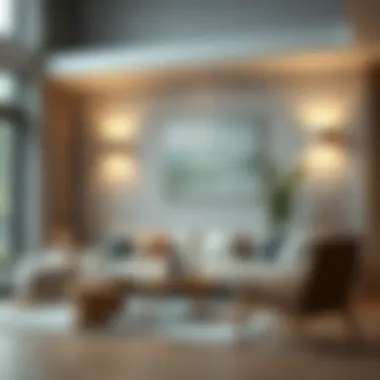
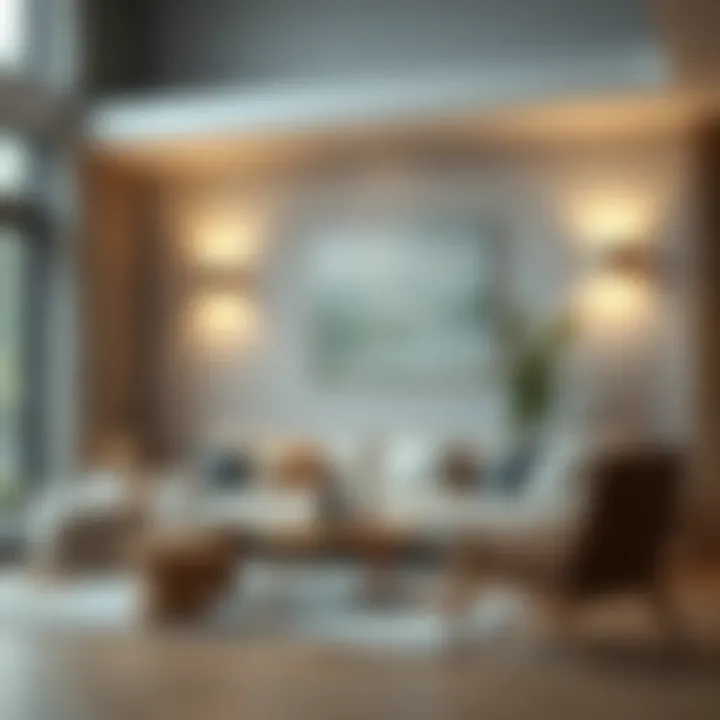
Striking a balance with overhead lighting is crucial; too much overhead brightness can feel harsh and uninviting. For example, consider a modern living room outfitted with a stunning chandelier. While it serves as the main light source, side lights can effortlessly temper this intensity, creating zones of comfort.
- Dimming Switches: Installing dimmer switches for both side lights and overhead lighting allows homeowners to tailor the brightness according to the occasion. Evening gatherings? Lower the overhead light and let the side lights dazzle with a warm glow, crafting an inviting intimate setting.
- Adjusting Height: Placement of side lights at varied heights can also play a pivotal role. Whether they stand tall beside a sectional couch or hang low as wall sconces, they can direct focus away from ceiling fixtures and towards cozy corners of the room.
Key Factors to Remember:
- Fixture Style: Ensure the design of side lights resonates with that of overhead lighting; cohesion in style brings visual unity.
- Color Temperature: Mixing different color temperatures should be avoided, as it can invite confusion in an otherwise seamless design.
Achieving a well-lit space takes thought and consideration. The integration of side lights with other lighting creates an environment that feels lived-in and personalized. When done right, layering lighting doesn’t just mean illuminating a space, but crafting an experience that speaks to your personal style.
Exploring Contemporary Trends
Contemporary trends in living room design are continually evolving, and side lights play a vital role in shaping these changes. As homeowners and designers alike strive for optimal functionality while maintaining aesthetic appeal, side lights have emerged as a bridge between utility and style. Understanding these trends helps in creating an atmosphere that caters to modern sensibilities, bridging comfort, technology, and environmental consciousness.
Smart Lighting Integration
In the age of technology, integrating smart lighting has become a necessity rather than just a luxury. Side lights equipped with smart capabilities allow homeowners to control illumination with ease. Whether it's adjusting brightness with a mobile app or setting specific schedules, smart side lights offer unparalleled flexibility. This not only enhances user experience but also contributes to energy efficiency.
The benefits don’t just stop there; these smart solutions often come with color-changing features that cater to mood or occasion. Imagine hosting a dinner party, and with a few taps on your phone, you can change the hue of your side lights to a warm amber, creating a cozy and inviting ambiance.
Some specific considerations when pondering this integration include compatibility with existing smart home devices and the potential for voice activation through platforms like Google Assistant or Amazon Alexa.
Sustainable Options
Sustainability is more than just a buzzword; it reflects a shift in consumer values. This trend emphasizes the importance of eco-friendly side lights. Many designers now look for fixtures made from recycled materials or sustainable sources, such as bamboo or reclaimed wood.
Utilizing LED bulbs, which are not only energy-efficient but have longer lifespans, is another important aspect of this trend. These bulbs reduce energy consumption significantly, leading to lower utility bills and less frequent replacements.
When selecting sustainable side lighting options, consider examining brands that adhere to environmental standards. It's worth noting that several organizations, such as the U.S. Green Building Council, provide certifications that can guide eco-conscious consumers.
"Choosing sustainable options today means creating a lighter footprint for tomorrow."
Common Mistakes to Avoid
When designing with side lights in living rooms, there are a few stumbles that can easily be sidestepped. Understanding and avoiding these common mistakes can make a significant difference in how effective the lighting is and how it complements the overall aesthetic of your space.
Overly Bright Fixtures
Choosing the right level of brightness for side lights is crucial. Selecting overly bright fixtures can turn your cozy living room into a harshly lit interrogation room, sucking the warmth right out of the atmosphere. Intense lighting can create a glaring effect that not only overwhelms the senses but also makes it difficult to relax. Instead of fostering a welcoming vibe, too much brightness might give the impression that you're artificially illuminating a theater stage.
To dodge this pitfall, aim for fixtures that offer adjustable brightness or soft diffused light. Consider using dimmable bulbs or light fixtures that enable you to control the intensity seamlessly. This way, you can enhance ambiance by tailoring light levels to different activities—whether it’s curling up with a book or hosting a lively gathering.
Neglecting Scale and Proportion
Another common blunder many make is neglecting the scale and proportion of side lights in relation to their surroundings. Imagine placing a tiny sconce beside an oversized couch; it’s akin to putting a tricycle next to a skyscraper. Such contrasting sizes can make a room feel disjointed and unbalanced. It’s all about creating harmony within the space.
When selecting side lights, always keep the scale of your furniture and overall room size in mind. A general rule of thumb is that the height of the light fixture should relate to the height of the furniture it’s paired with. For instance, if you're flanking a tall armchair, opt for taller side lights. This balances the visual weight and contributes to a more cohesive look.
"Getting proportion and scale right with side lights can elevate a room from merely decent to downright stunning."
In wrapping these ideas up, while side lights can be the cherry on top of an impeccable living room design, avoiding these common mistakes will ensure that your efforts lead to delightful outcomes. With a bit of thoughtful planning, your side lights can perfectly complement your decor, offering both functionality and style.
Maintenance and Care for Side Lights
Caring for your side lights is not just about keeping them looking good; it plays a crucial role in sustaining their functionality and enhancing the overall aesthetic of your living room. Over time, dust and grime can accumulate, dulling the brightness that these fixtures are meant to cast. Plus, neglected lights can become more than just a visual nuisance; they can also lead to issues like flickering or dimming over time, which could signify more significant electrical problems. Thus, regular maintenance ensures that your lighting remains both beautiful and functional.
Regular Cleaning Tips
Dusting and cleaning side lights is simple yet often overlooked. Here are some straightforward tips to keep them in tip-top shape:
- Use a soft cloth: A microfiber cloth can work wonders without scratching surfaces. Make it a habit to dust the lights weekly to prevent buildup.
- Avoid harsh cleaners: Chemicals can degrade finishes; instead, a damp cloth with a bit of vinegar or mild soap will do the trick.
- Check the shades: If you have fabric or glass shades, they may require a deeper clean now and then. For fabric, consider a gentle vacuuming. Glass shades can usually be washed with soap and water but ensure they are completely dry before reinstalling.
- Turn off the power: Prior to cleaning, always shut off the power to your lights. Safety first!
Keeping your side lights clean doesn't just enhance their appearance. It also improves the quality of light emitted and helps maintain a welcoming vibe in your living room.
Replacing Bulbs and Fixtures
At some point, all bulbs burn out, and some fixtures might need replacement. Knowing how to handle these changes is essential:
- Choose the right bulbs: Consider LED options. They last longer and are more energy-efficient than traditional incandescent bulbs. Plus, they come in a variety of color temperatures, enabling you to achieve the perfect ambiance.
- Follow guidelines: When replacing bulbs, check the wattage recommendations specified by the fixture's manufacturer. Overwattage may cause serious risks, including fire hazards.
- Fixture updates: If a fixture looks worn out or is not functioning properly, replacing it might just be the refresh your living space needs. Choose a design that complements your overall aesthetic while also providing optimal lighting.
- Hire a professional: If you are unsure about any electrical work, it’s wise to consult with an electrician. DIY can sometimes lead to bigger issues, especially when it involves wiring.
Ending
In this exploration of side lights, we've unraveled their pivotal role in enhancing both the aesthetics and functionality of living spaces. Side lights are not merely supplementary lighting; they serve as an essential component that harmonizes the entire room. This article has detailed their styles, placements, and materials, emphasizing how each element contributes to creating a cohesive living environment.
The proper integration of side lights can transform a mundane area into a visually appealing sanctuary. They craft warmth, drawing focus to architectural features or art pieces, while simultaneously providing practical illumination. For homeowners, designers, and DIY enthusiasts, understanding the nuances of side lights provides a significant advantage in designing inviting spaces.
"Effective lighting is the silent curator of your home's ambiance, enhancing mood without uttering a word."
Recap of Key Insights
- Aesthetic Value: Side lights elevate the room's visual appeal by surrounding furniture with light, creating depth and texture.
- Functional Purpose: They balance overhead lighting and create cozy nooks for reading or relaxation, essential in any living area.
- Varied Styles: From modern minimalism to classic elegance, the variety of styles available allows for personalized expression through lighting choices.
- Placement Matters: Correct positioning of side lights can significantly affect the ambiance, guiding the flow of light and attention within the space.
- Integration with Modern Trends: Keeping up with contemporary advancements, such as smart technology or sustainable materials, can enhance both functionality and aesthetic.
Final Thoughts on Side Lighting
In the end, side lights are not just an afterthought; they are a critical design element that impacts how spaces are experienced daily. Their ability to affect mood and functionality cannot be overstated. As we continue to embrace intricate design dynamics, let us appreciate the role of side lights—and incorporate them thoughtfully into our living spaces. They offer an opportunity to blend practicality with creativity, ensuring your home is not just occupied but truly lived in. Every flick of a switch can illuminate more than just a room; it can light up moments of gathering, connection, and comfort.









